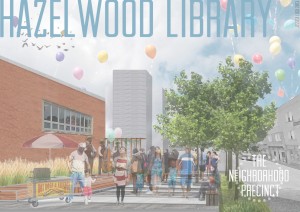
And instead of parking spaces along Hazelwood’s Second Avenue, Ramos would love to create a network of parklets. After hearing from community members, he developed a plan to make the main drag in this community along the Monongahela River more walkable, more accessible to pedestrians.
“It’s not just planting trees or plants, it’s creating an environment that puts someone in a certain mood. We’re taking consideration of how someone feels in their space.”
— Aaron Ramos, landscape architecture student
Ramos and 11 other fourth- and fifth-year Penn State landscape architecture students are wrapping up their experiences in the Pittsburgh Studio, a five-credit class that puts them in target communities in the city and surrounding urban areas, and charges them to create conceptual designs that can help people imagine what their hometowns could become.
Ramos has worked all semester on conceptual landscape plans for the Hazelwood Library and surrounding spaces. He’s had to interact with residents, local government officials and representatives of nonprofits for the past several months. He said he’s motivated by the Pittsburgh Studio’s practice of “co-design,” a style of engaged learning based on active community participation.
“Once you meet these people, you connect and grow relationships with them and you feel responsible for what you design,” Ramos said. “I take more ownership with what I present to them and they take ownership, too.”
The class presented their projects on Nov. 19 to members of the Hazelwood community at an open house inside a chilly church hall along Second Avenue. Almost everyone there kept their jackets on and zipped up. The students used a wireless microphone that was buzzing intermittently with feedback. The old building’s heating system repeatedly interrupted them as clanging radiator pipes startled the speakers and the audience. These distractions, which often happen in a real world setting like a community meeting, are not always found in a classroom.
Leah Grosso (fourth year/landscape architecture) said the Pittsburgh Studio has given her valuable person-to-person experiences that she would not have necessarily received in a traditional classroom setting at University Park.
“In my other classes, our clients have either been our professors or imaginary, but in the Pittsburgh Studio, we’re designing for actual community members: people with hopes, quirks and aspirations,” Grosso said. “This studio is based on practical problems and real-world experience. If we didn’t have community members talking to us, we wouldn’t have a class. Hazelwood is literally our classroom.”
Ken Tamminga, professor of landscape architecture in the College of Arts and Architecture, has been encouraging students for the past six years to help stressed neighborhoods recapture “pride of place” by using design, art and landscape as the catalysts for their vision.
Tamminga’s studio, in partnership with The Penn State Center: Engaging Pittsburgh, works with community partners in various Pittsburgh neighborhoods. Under the leadership of Tamminga and Deno De Ciantis, director of The Penn State Center, the students create regenerative designs that aim to meet the vision of community leaders, residents and other stakeholders to improve the landscape of each neighborhood.
“The students get to tap into that energy. They bring professional expertise, precedent and theory but what they soon realize is they don’t know the place. They don’t know the neighborhood’s backstory or its nuances so when they get together with local folks, there’s this interesting process of reciprocal learning.”
— Ken Tamminga, professor of landscape architecture
Once the students’ conceptual projects are completed, neighborhood leaders often work with The Penn State Center to establish strategies to move the plans toward reality.
“This is a great opportunity for the students to meet the actual stakeholders of areas they plan on designing,” said Lisa Kunst Vavro, manager of sustainable landscapes for The Penn State Center. “Without the vision and engagement of the community, there could be no studio and no design.”